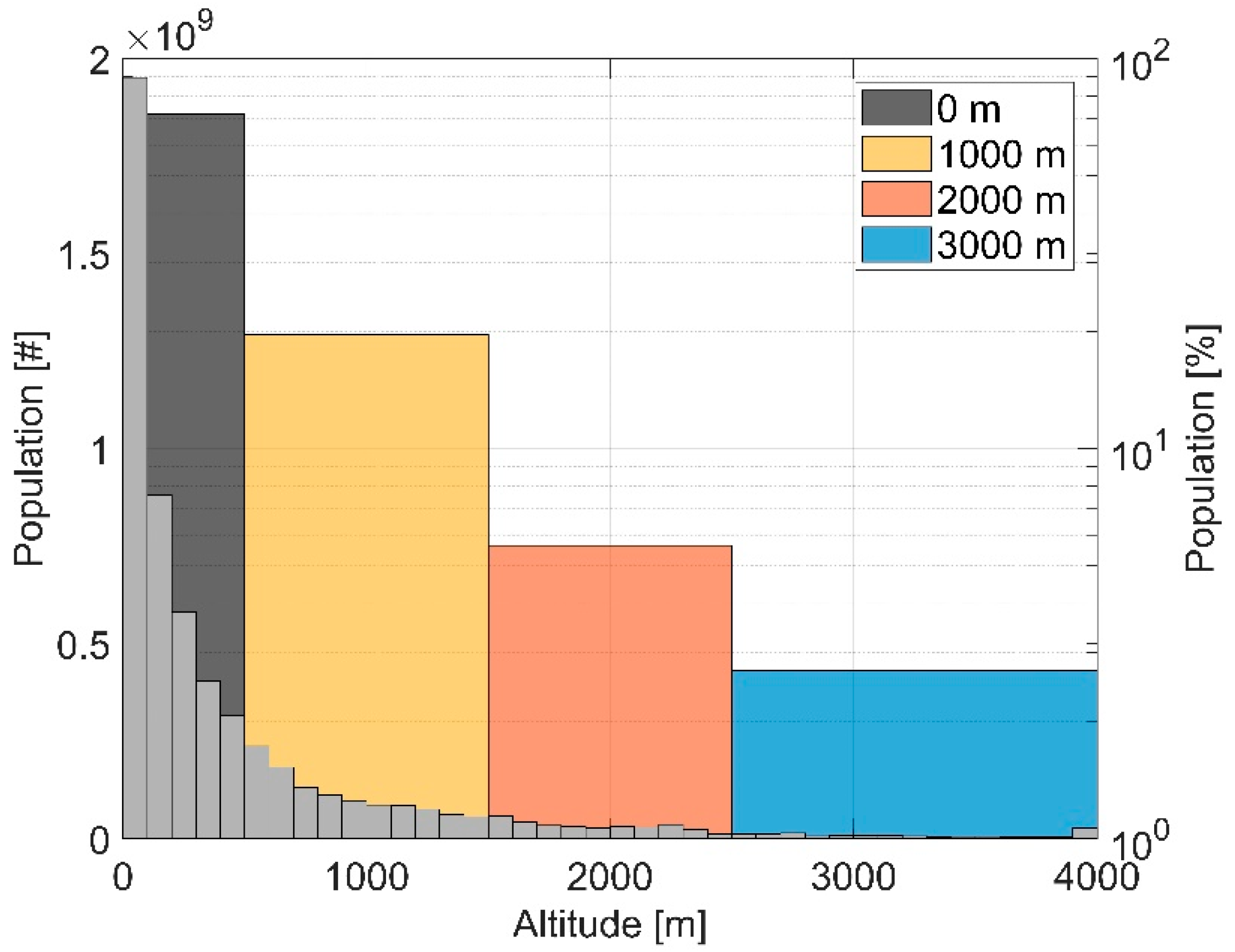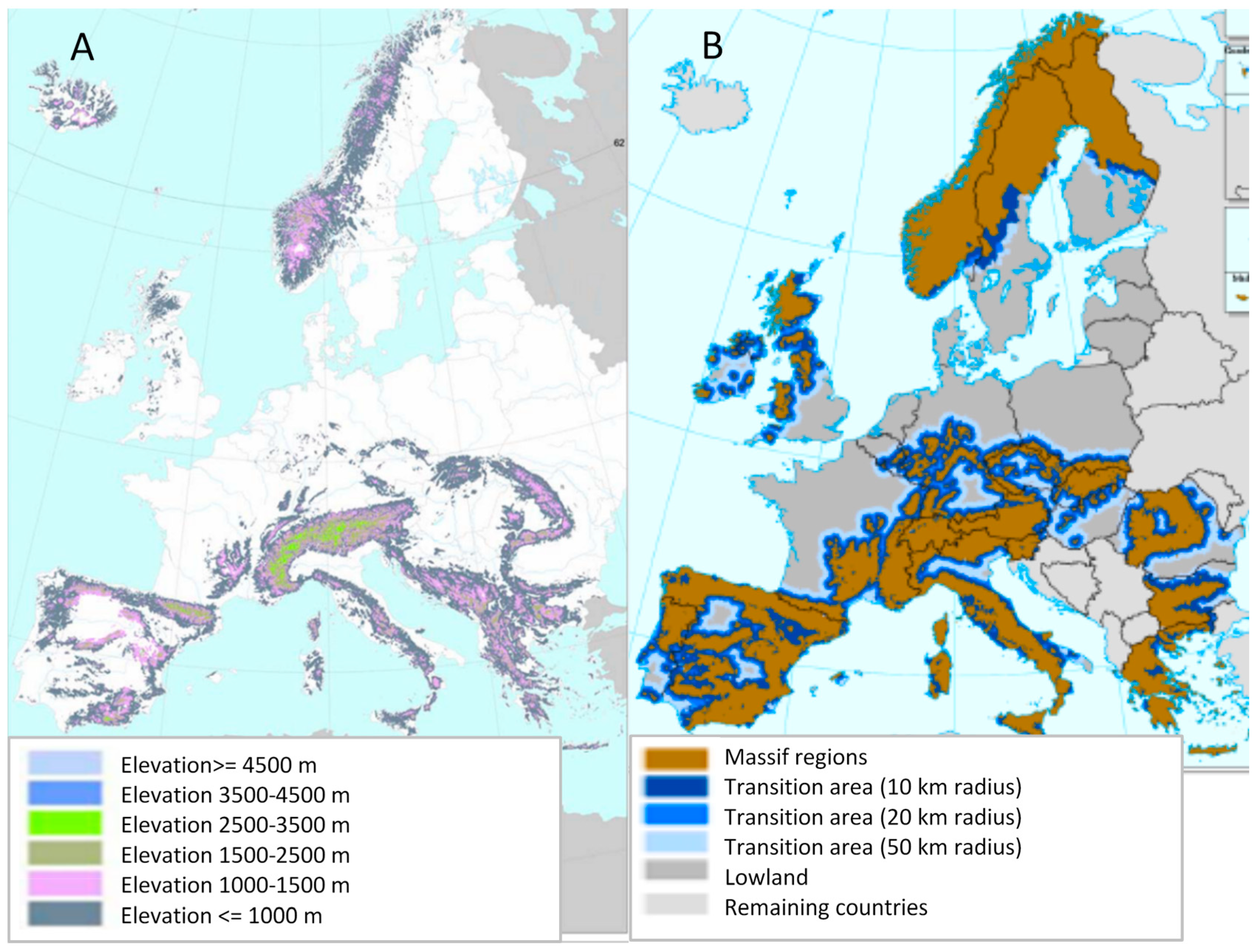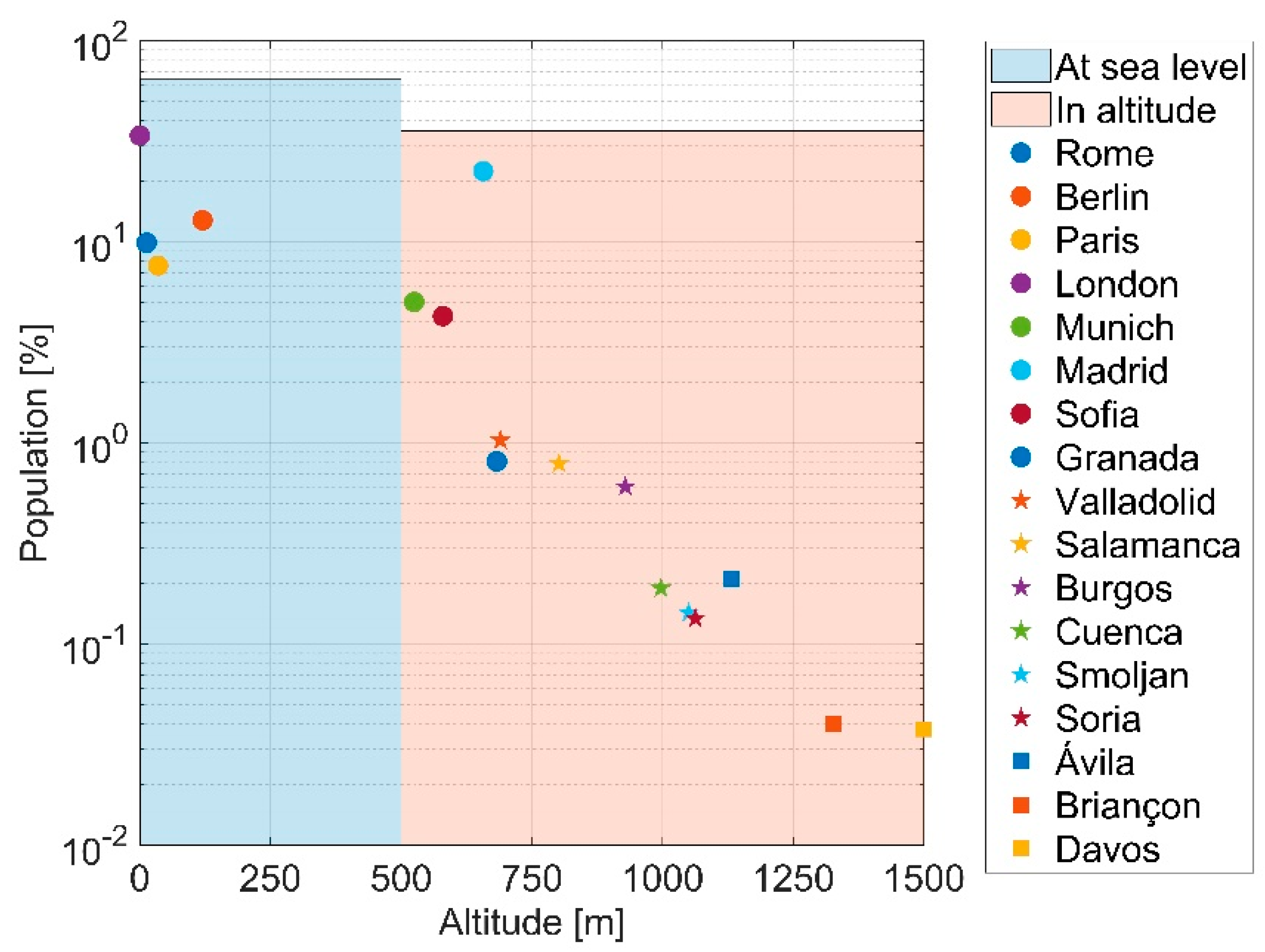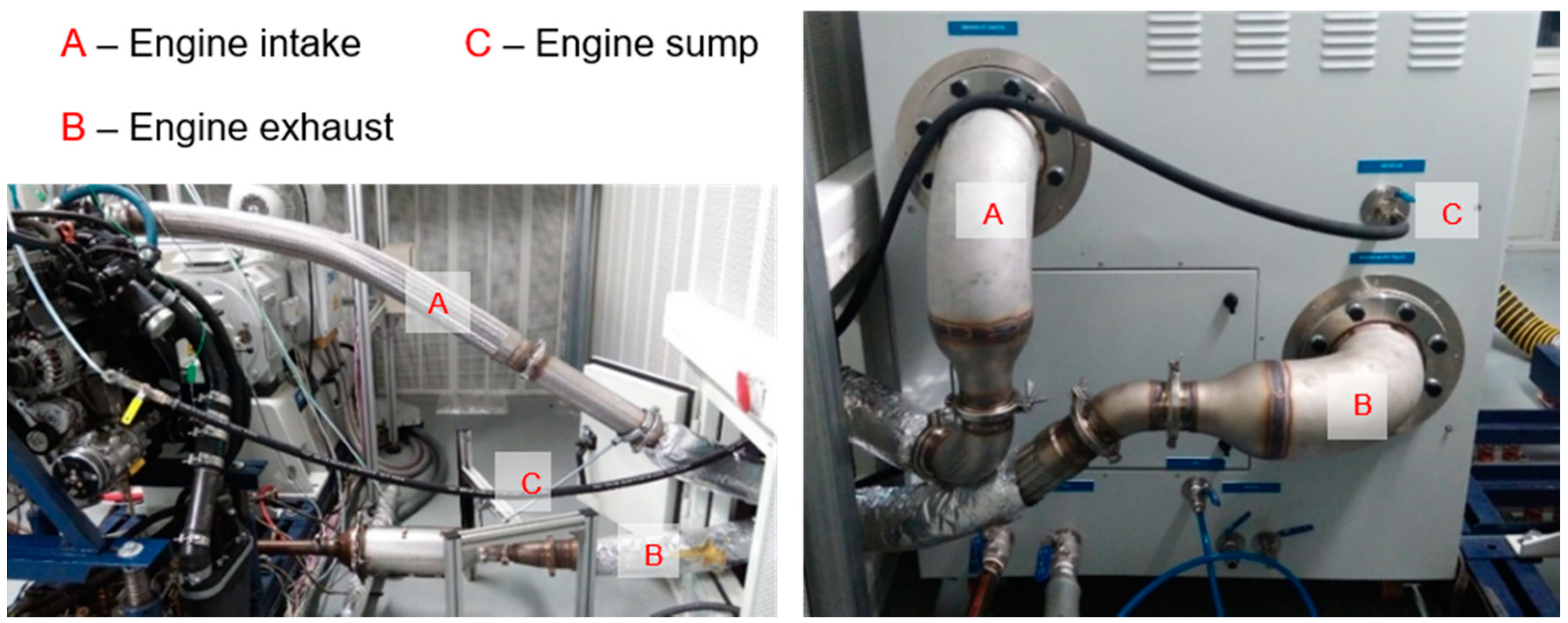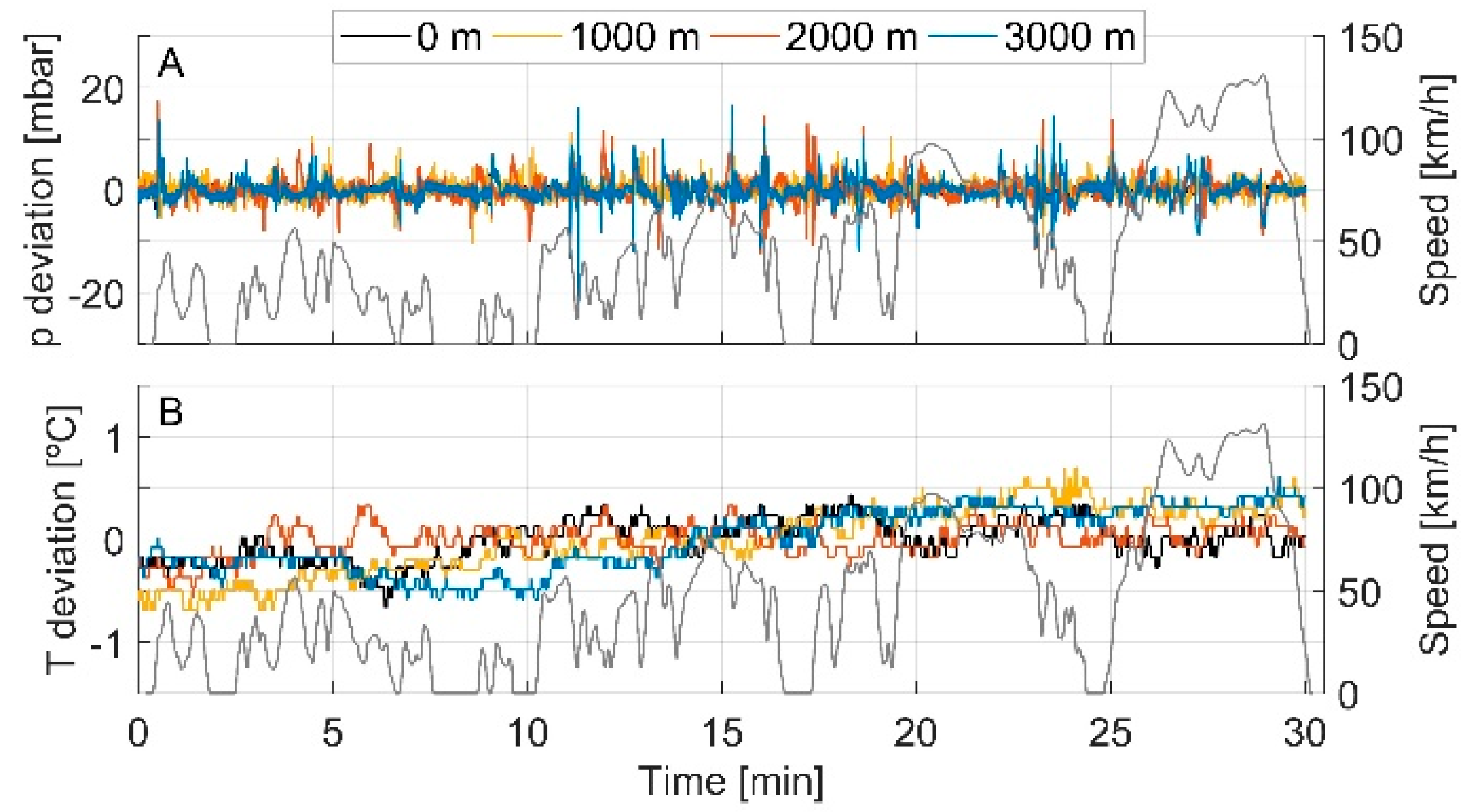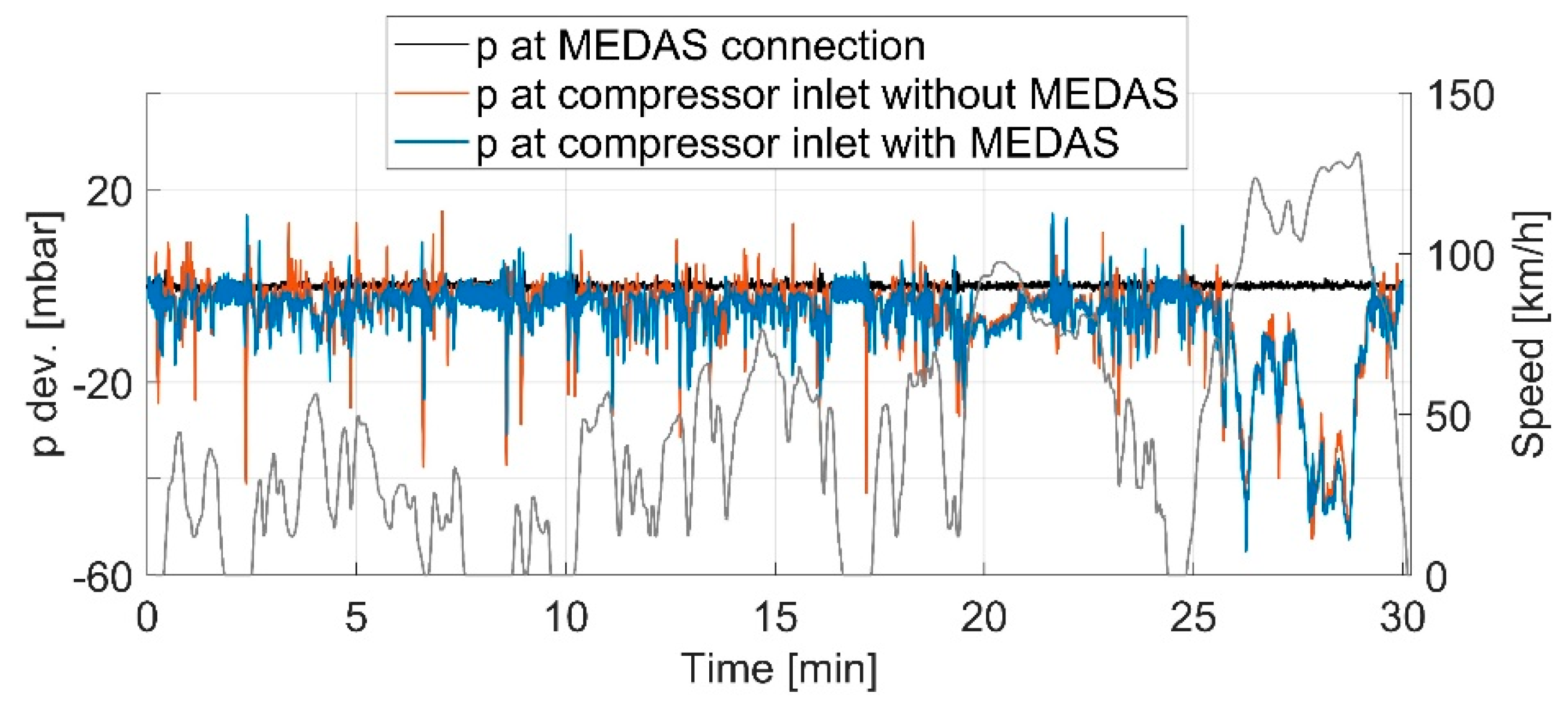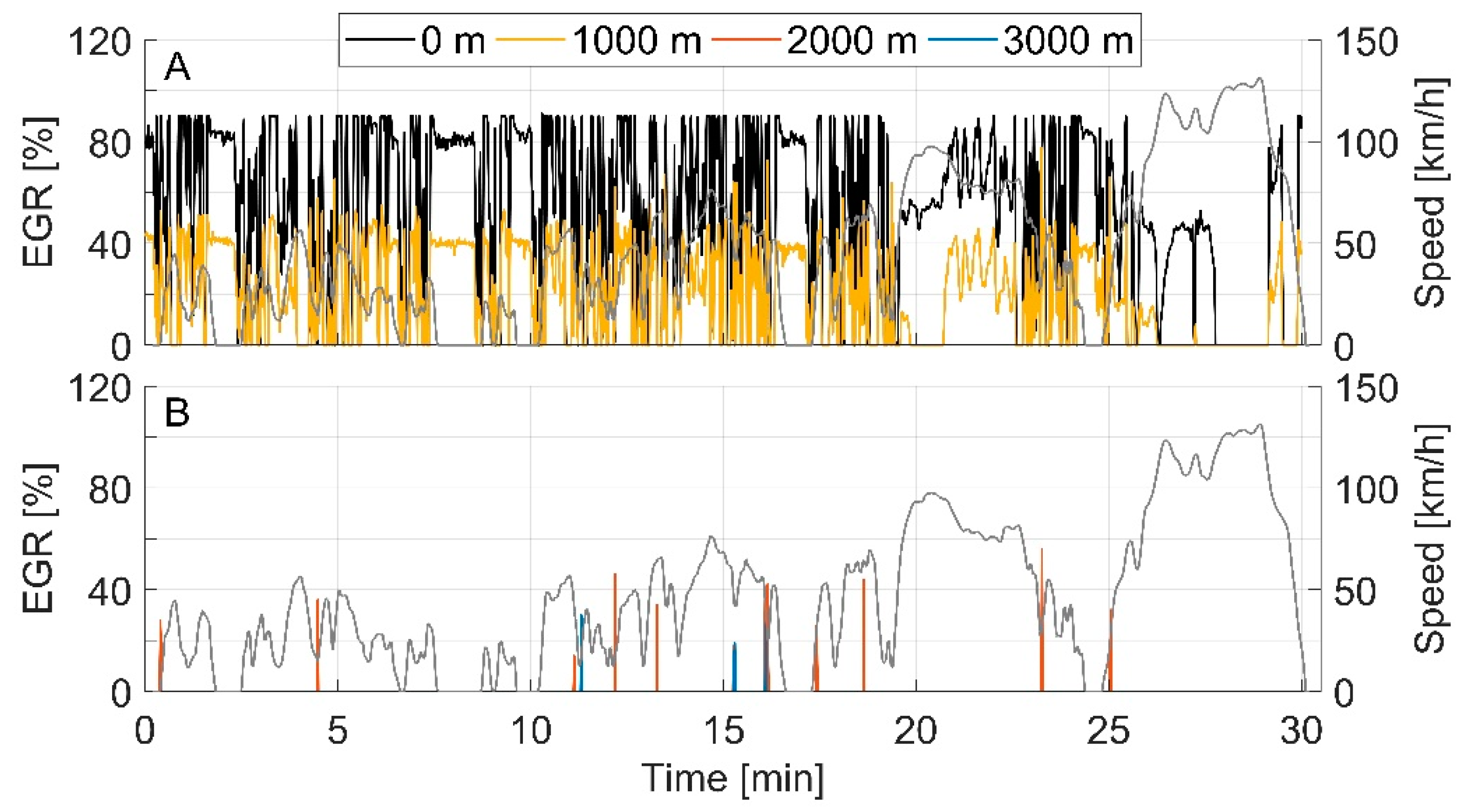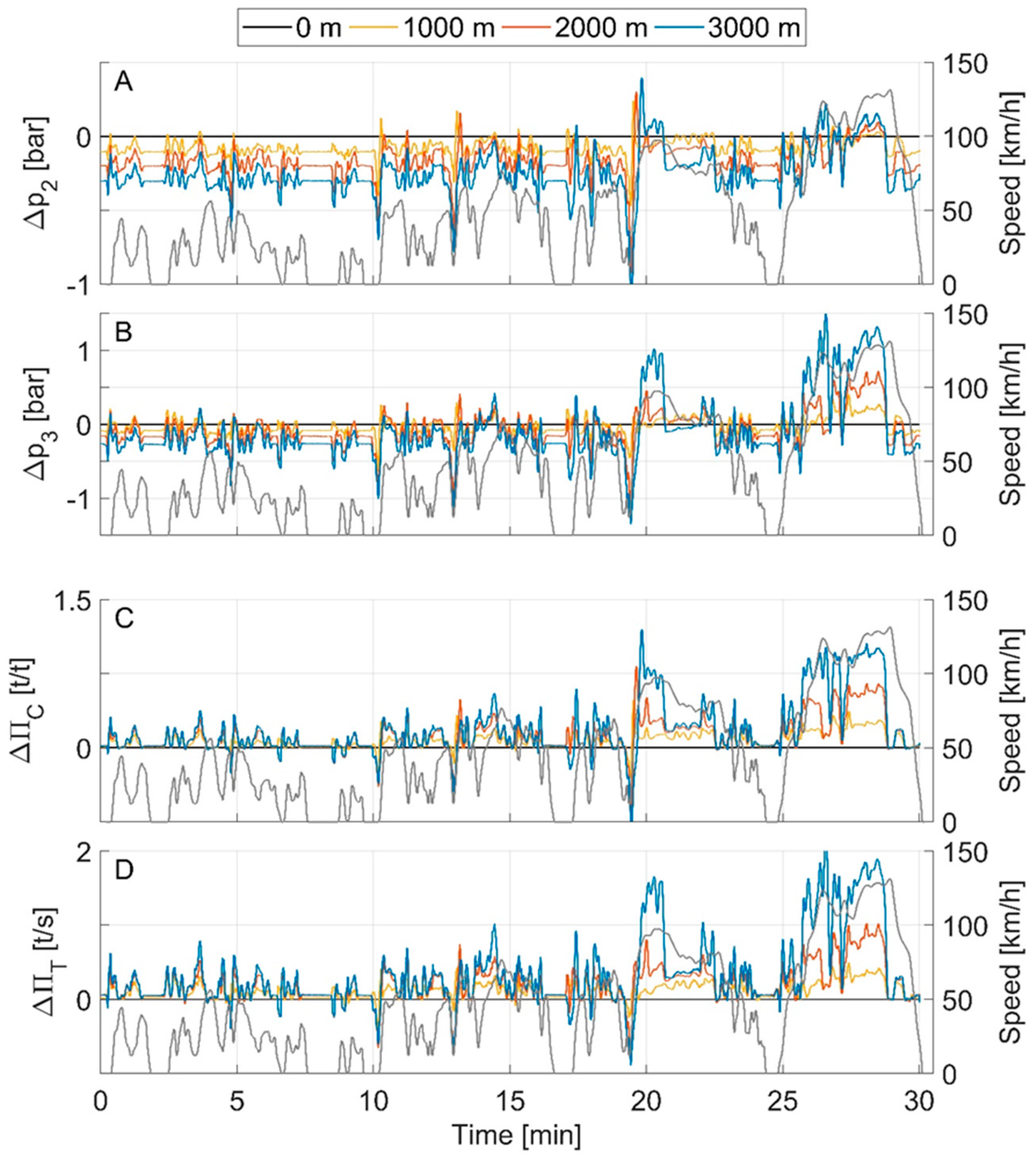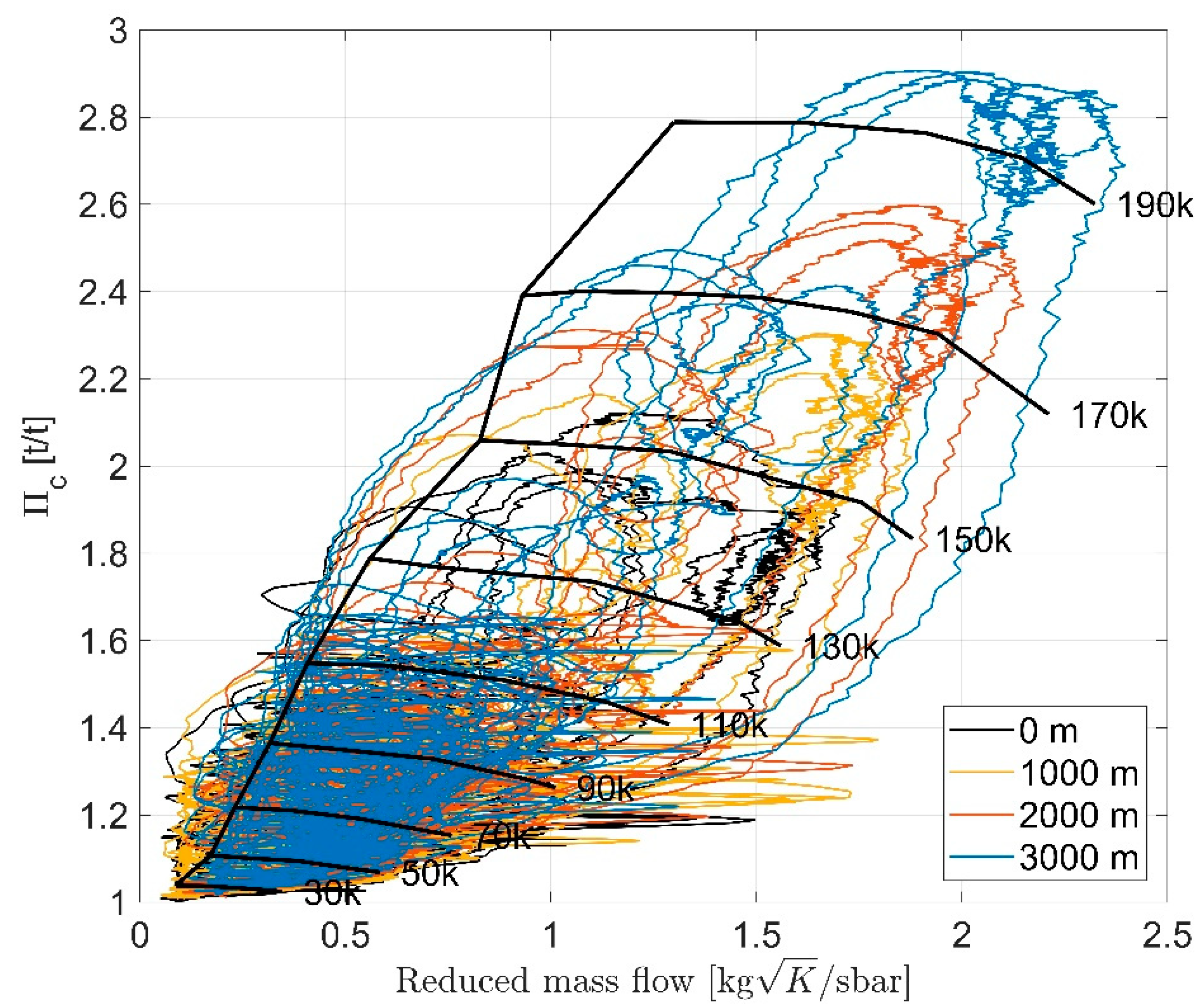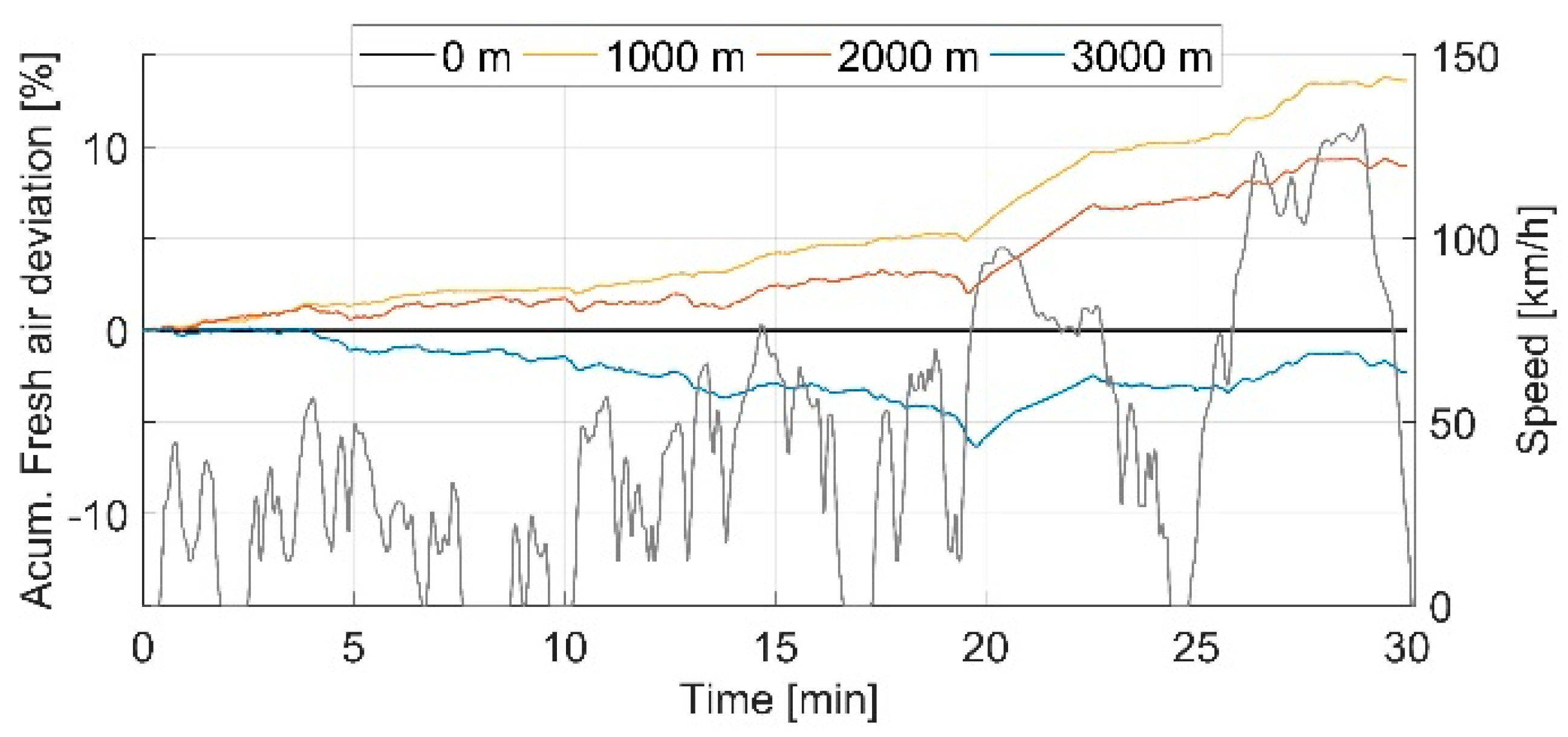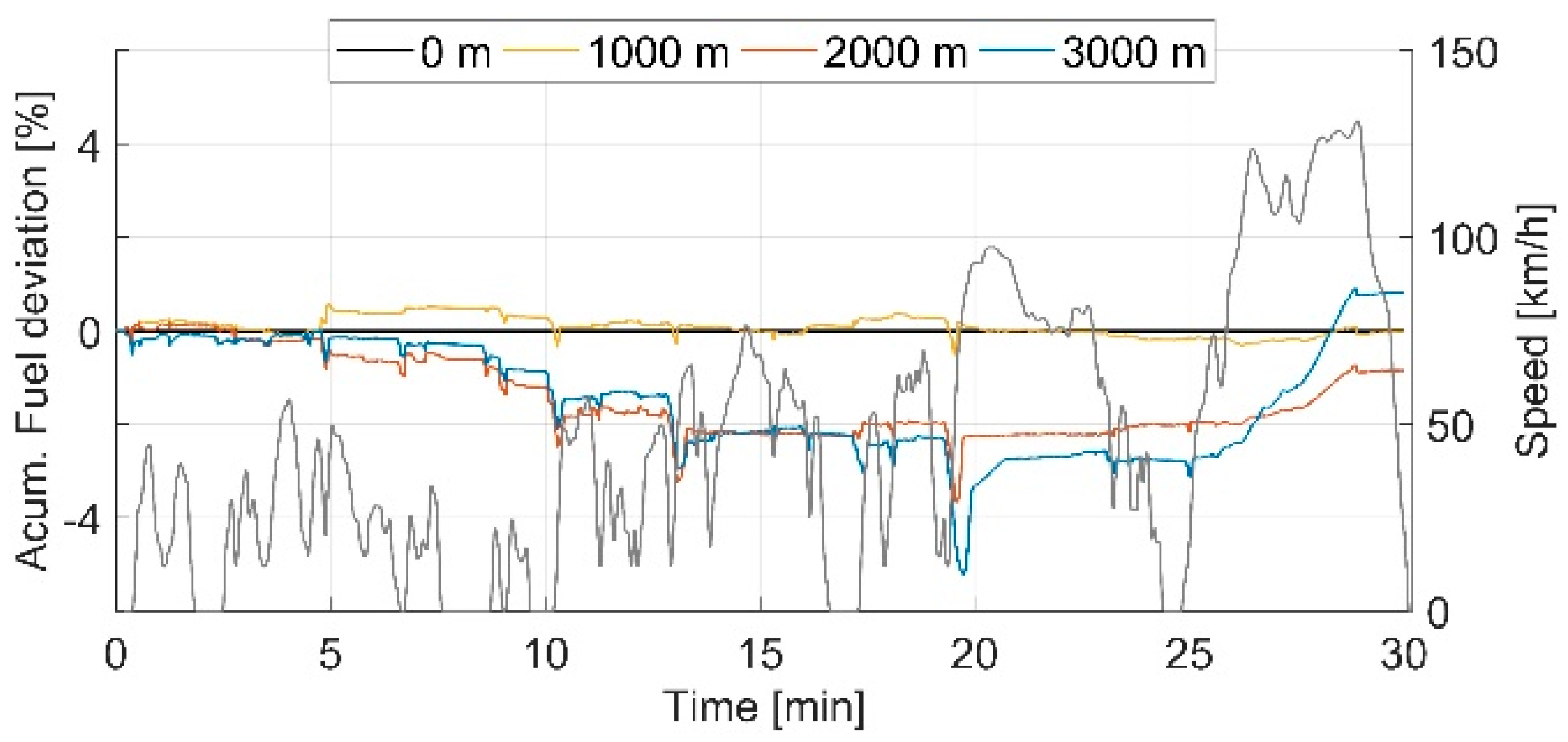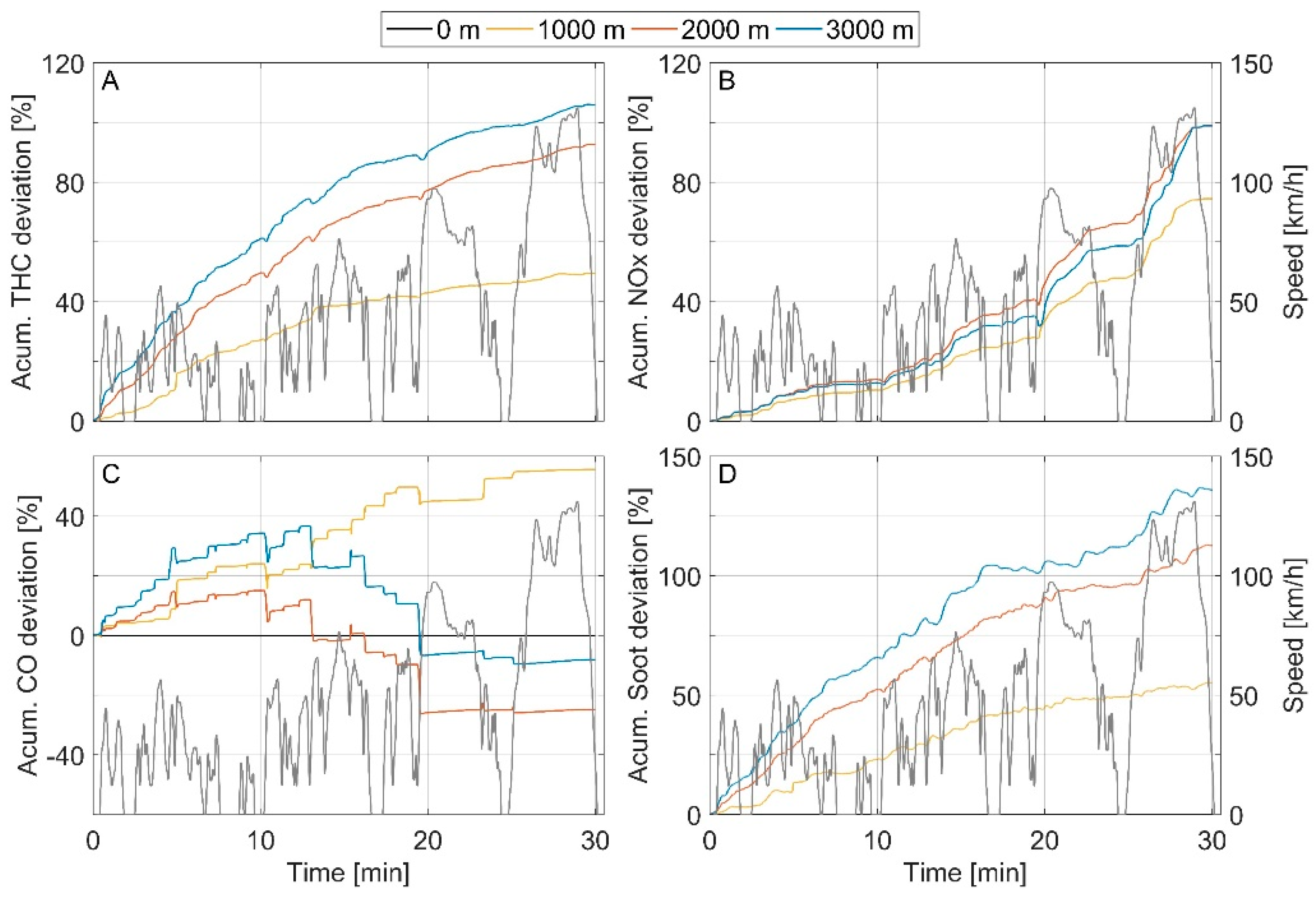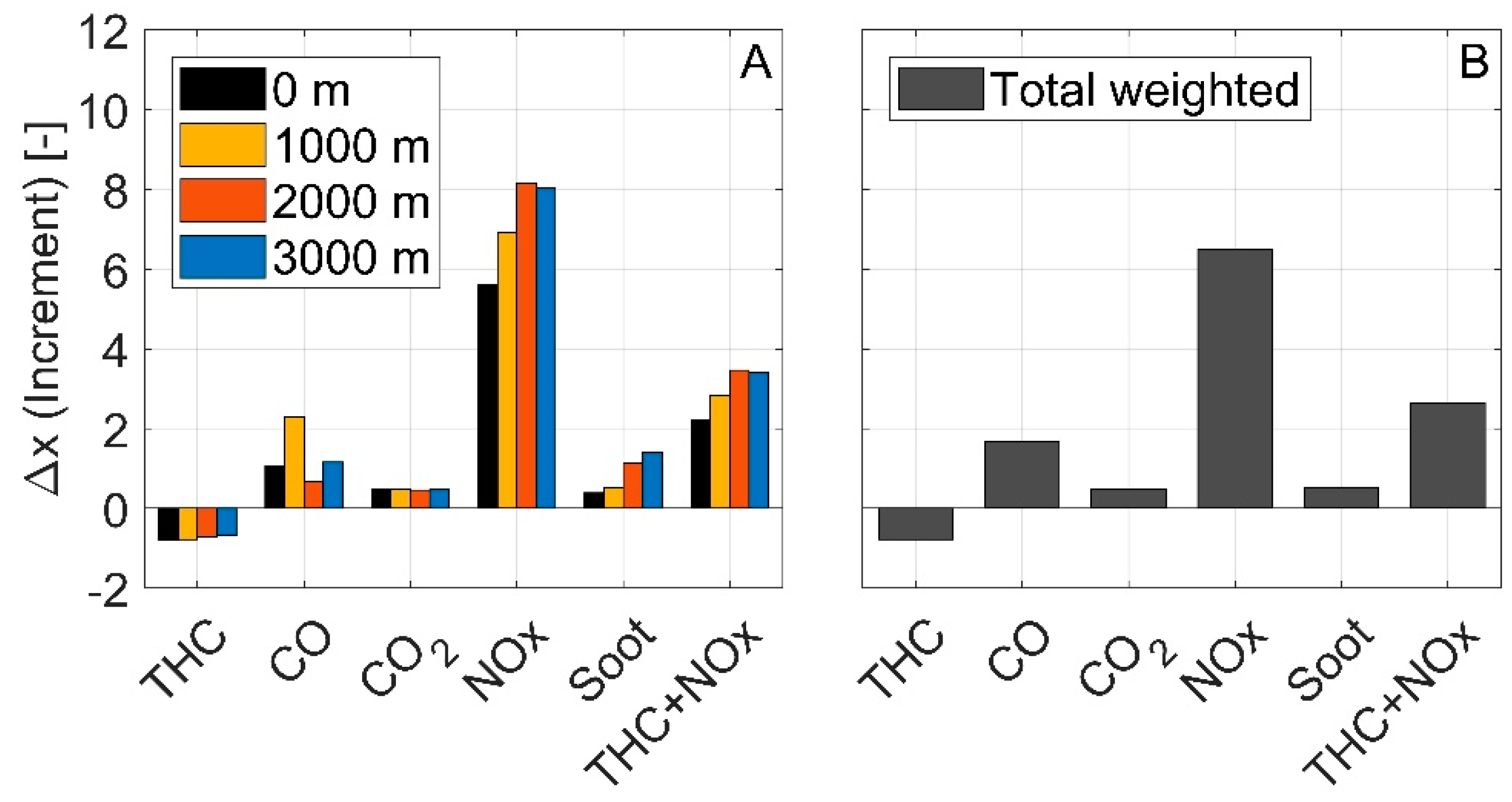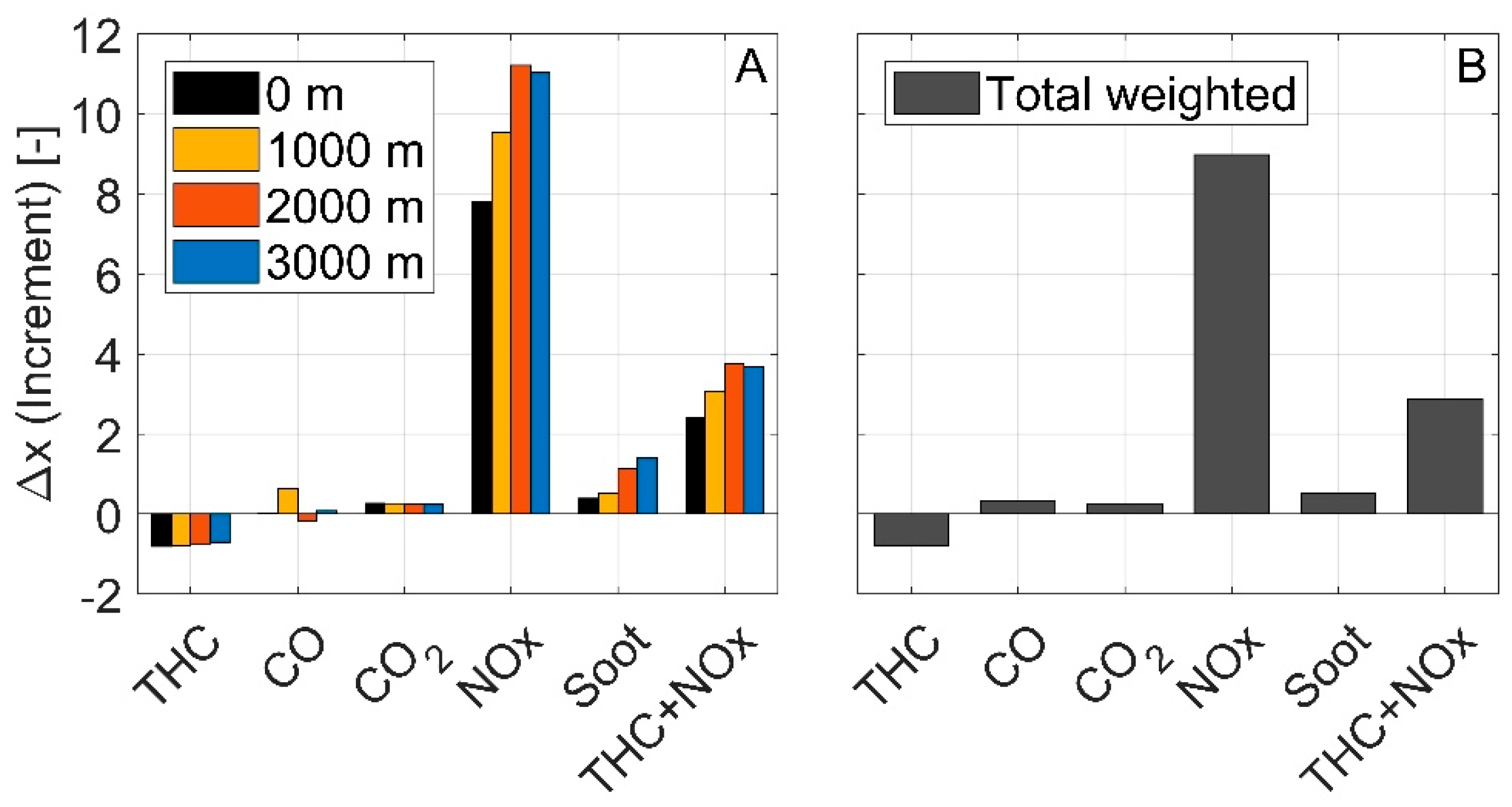1. Introduction
As new internal combustion engines emission regulations are implemented, the automotive engine manufacturers look for new control strategies and technologies to face the challenge of the increasingly restrictive limits to pollutant emissions [
1]. Obviously, the benefits of this research are limited to new vehicle models appearing in the market. Nevertheless, according to data from the European Automobile Manufacturers Association (ACEA) in 2017 [
2], when Euro 6d-Temp came into force for the new types of passenger cars, 174 million cars circulating were Euro 4 or older and 41% of them were diesel engines. They are about 71 million and at least 10 years older than the nowadays Euro 6d-Temp commercialized diesel engines. This is a considerable number of vehicles that are circulating without fulfilling modern regulations. Therefore, it is important to analyze how these vehicles respond at the light of the nowadays homologation procedures.
The Real Driving Emissions (RDE) test includes altitude as a new relevant homologation variable. In parallel, Worldwide harmonized Light-vehicles Test Cycle (WLTC) [
3] is used as a baseline to represent real driving conditions at engines laboratories. It is generally accepted that the fuel consumption and emissions of internal combustion engines are deeply affected by the altitude conditions [
4,
5]. This is due to the control strategy of the turbocharger or the combustion, which makes the engine operate closer to its mechanical limits. The engine power is even severely affected by the altitude despite the boosting system availability [
5]. The turbocharger strategy increases the backpressure to keep the boosting, which increases the backflows in the exhaust ports and the pollutant emissions [
6]. In addition to the effect that the in-cylinder pressure has over the behavior of the injected fuel spray, the increase in altitude lowers the pressure and the density of the air despite the turbocharging [
7]. Consequently, a decrease of the spray angle is found [
8] and the spray penetration increases. By contrast, the lower density reduces the fuel drop size giving, as a result, lower coalescence [
9,
10] and improving the evaporation of the fuel and its mixture with the air.
There are different options for testing an engine in order to analyze the altitude-induced phenomena and their effects on the engine performance and emissions. The first one is to perform real driving tests. However, this approach involves very high costs, low accuracy, low repeatability, and provides limited understanding of the governing phenomena. The hypobaric chambers emerge as an option, which solves the drawbacks of the real driving tests while keeping the vehicle environment as close as possible to real conditions. This option has been the most commonly used in the past and during the initial phases of the engine calibration. Nevertheless, it includes drawbacks: Low availability, due to the extensive planning and investment necessary for its construction, and high energy consumption. In addition, working inside hypobaric chambers comprises a health risk since the human body cannot withstand continuous pressure changes [
11]. This limits the number of hours that the driver can be inside the chamber carrying out dyno tests. Lastly, there is the option of using an altitude simulator, which generates the desired altitude inside the intake and exhaust engine pipes, while keeping the rest of the engine at room conditions. This characteristic allows the study of the engine behavior in altitude without the limitations of the previously mentioned facilities. An example of this kind of equipment is the one presented by Testa et al. [
12], in which the engine is connected to two root compressors, which control the environment working pressure. The volumetric compressor in the engine intake works as a throttling valve to generate vacuum while the one in the exhaust tailpipe end generates the flow movement. Contrarily, when simulating overpressure, the compressor moving the flow is the one in the intake while the exhaust one is acting as a backpressure valve.
This paper proposes combining altitude and WLTC in a number of experiments performed in laboratory-controlled testing conditions as representative as possible of RDE tests for old Euro 4 diesel engines, which are investigated in this work. A Euro 4 turbocharged diesel engine has been tested performing the WLTC cycle and connected to the altitude simulator HORIBA MEDAS (Multifunctional Efficient Dynamic Altitude Simulator) [
13,
14,
15] to emulate different altitudes. The operating principle of the atmospheric simulator, which is composed of MEDAS and two performance extension modules (MEDAS Temperature Module (MTM) and MEDAS Humidity Module (MHM)) is explained in detail in References [
6,
16,
17]. These three systems will be referred hereinafter as altitude simulator (AS). AS is tasked to control the three main psychrometric variables of the atmosphere: Pressure, temperature, and humidity. The use of the AS has been previously validated against a hypobaric chamber [
17] by carrying out steady-state tests covering most of an engine working map. Also, its control stability while coupled with an engine performing load and speed cycles has been validated in two different situations: Keeping constant altitude, i.e., simulating a plateau [
6], and reproducing the climb and descent of a mountain [
17]. The results of these laboratory-controlled cycles are used to identify the primary causes of the pollutant peaks during altitude driving. As an important corollary, this kind of test allows quantifying and concluding that just the replacement of Euro 4 fleet would mean a very important reduction of pollutants emission from passenger cars.
Therefore, this study has been carried out to deeply analyze the behavior of a Euro 4 diesel engine when working at sea level and in different altitude conditions. Also, it is an objective to analyze the performance of Euro 4 vehicles in circulation under the current emission regulation standard cycle (WLTC). This combination of objectives has been conceived as an innovative, fast, and straightforward way to calculate the reduction of current pollutant emissions if the Euro 4 passenger-car diesel fleet was replaced. The inclusion of the altitude scenario provides further insights in the analysis by considering the average topography of the EU market. The calculation of this reduction of pollutant emissions basing the analysis on realistic driving conditions (WLTC plus altitude) can provide valuable information for opinion makers and authorities to encourage political actions towards vehicle fleet renewal.
In the first section, a study about the general topography of the EU has been carried out. This is followed in the second section by the description of the engine test bench, the AS, and the instrumentation used. Afterwards, in the third section, the engine results obtained from the tests carried out are analyzed and discussed. Finally, a study of the impact over the European and Spanish local and global emissions of replacing the current Euro 4 diesel vehicles is shown in the fourth and fifth sections.
5. Analysis of the Benefits of Euro 4 Diesel Engines Replacement in European Roads and Cities
In 2017, the European Automobile Manufacturers Association carried out a study about the European automotive fleet [
2], from which an estimation of the number of Euro 4 diesel vehicles that are currently circulating through European roads and cities has been obtained.
The information extracted about the European passenger car fleet from [
2] is as follows:
Proportion of passenger cars with a diesel engine: 41%.
Total number of passenger cars circulating in the European Union: 252,043,348 cars.
Number of vehicles in use in the European Union, which were registered for first time before 2007: 123,433,397 cars.
Number of vehicles in use in the European Union, split by year of first registration from 2007 up to 2015: 128,609,961 cars.
Then, taking into account the period of application of the Euro 4, 5, and 6 legislations (
Table 3), the number of cars registered for the first time during a given Euro regulation period can be calculated. It is done by adding the passenger cars currently in use that were registered in the years that make up its application period, and assuming that until September 2009, 67% of the sales of that year had been made.
Therefore, the proportion of Euro 4 or older diesel passenger cars currently circulating through the European Union can be calculated following Equation (2), where
is the number of vehicles in use in the EU which were registered in 2007, 2008, and from January to September of 2009 (67% of 2009 total registrations);
is the number of passenger cars currently in use in the EU, which were registered for first time before 2007;
is the proportion of diesel passenger cars in the EU; and
is the total number of passenger cars circulating through the EU.
Then, the number of diesel passenger cars that meet Euro 4 or older regulations and are currently circulating in the EU can be estimated as 28.5% of the total European passenger car fleet, which means around 71 million passenger cars. This fact combined with the results shown in
Figure 13 prove that the Euro 4 diesel engines have a significant impact in the current pollutant emissions through Europe. It leads us to think about what would happen to Europe’s emissions levels if, in addition to more tight legislation, the renewal of the automotive fleet is encouraged by the governments.
In
Figure 14A, the four main pollutants emitted by a diesel engine (THC, CO, NOx, and Soot) and CO
2 have been represented as a yield ratio (Δx) with respect to the new Euro 6d emissions limits. The ratios have been obtained following Equation (3), where
is the averaged value measured of a kind of pollutant during the WLTC cycle (shown in
Figure 13), and
is the corresponding Euro 6d diesel emission level (
Table 2).
It has been previously stated that the results shown in
Figure 13 are considered representative of an old Euro 4 diesel engine performing a modern cycle (WLTC) and including altitude as the real driving variable of the cycle (RDE). For the Euro 6d limit, diesel engines have been preferred to perform the comparison due to their GWP being, on average, 15% lower than petrol engines at equivalent vehicle size, according to the 2018 study from the Society of Motor Manufacturers and Traders (SMMT) [
22].
Figure 14A shows that, with the exception of THC, the rest of the pollutants and CO
2 increased with respects to the Euro 6d diesel standards. Particularly, a large increase in the emission of NOx was observed—more than 5 times the Euro 6d limitation when Euro 4 engine is at sea level and about 8 times in the cycles carried out in 2000 m altitude. In addition, an important increase of emissions, between 1- and 2-fold, for CO and soot, and up to 3 times for THC + NOx at 1000 m, have been measured.
Instead,
Figure 14B represents the previously described ratios between Euro 4 measurements and Euro 6d limits, weighting each altitude with the percentage of European population making displacements in the 50 km buffer area of massifs. The weighting factor for massifs was obtained from Reference [
19] and it is 60%; this percentage is illustrated in
Figure 2 and split in
Table 4 among 1000, 2000, and 3000 m altitude data. The splitting factor was obtained from Reference [
18], assuming that the world trend of population by altitude shown in
Figure 1 remains true at the European level for the 2000m and 3000 m altitude locations, i.e., 5% and 3% respectively, as shown in
Table 4. The remaining 40% has been assigned to sea level share assuming they never drive into the previous mentioned 50 km massifs buffer. From these results, it can be again concluded that the potential to reduce the air pollution removing aged passenger car is not negligible and it is worth being analyzed.
Additionally, if instead of renewing the Euro 4 diesel fleet with Euro 6d diesel passenger cars (
Figure 14), it is replaced by Euro 6d petrol engine cars (
Figure 15), the increase of pollutant emission with respect to the Euro 6d regulation changes significantly.
Figure 15A,B have been obtained following the same methodology as
Figure 14, but using the Euro 6d petrol emission levels in Equation (3) instead of Euro 6d diesel emission levels (
Table 2).
Figure 15B shows how the altitude-averaged increase in NOx emissions of Euro 4 diesel engines is higher on average with respect to Euro 6d petrol engines (9 times) than Euro 6d diesels (7 times, shown in
Figure 14B). However, the yield ratio of CO emissions of a Euro 4 diesel engine is reduced to almost zero if the renovation is carried out with Euro 6d petrol engines. The same happens with CO
2 emissions from Euro 4 diesel engines, since CO
2 emissions of Euro 6d Temp diesel engines are, on average, 15% lower in passenger cars of every sector [
22].
Lastly, the increment for soot and THC stayed equal between both options of renewal. In the case of soot, it was due to the fact that both petrol and diesel Euro 6d engines use particle filters that minimize soot emissions. With respect to THC, it is worth noting that even though the quantity emitted is similar between Euro 6d petrol and diesel engines, the composition is not. The THC emitted by petrol engines contains methane hydrocarbons (MHC), of which GWP is 25. Therefore, the MHC emitted by a Euro 6d petrol engine (up to 32% of the THC emitted [
3]) causes lower reduction of greenhouse emissions, when renewing the Euro 4 diesel engines by Euro 6d petrol engines.
6. Benefits of Euro 4 Diesel Engines Replacement in Spanish Roads and Cities as Example of European Country Analysis
In this section, the study of passenger cars circulating in Europe has been focused on a particular country and its corresponding urban environment. The same methodology could be followed for other countries. For this study, Spain has been taken as example of country with Madrid as an example of a big city at a massif and Barcelona as an example of a big city at sea level. The reason is the altitude perspective kept in this study is well exemplified in a country like Spain. According to Reference [
19], Spain’s average massif areas are higher than the EU average, such as Austria, Finland, Italy, Norway, Romania, Sweden, and Slovakia. In addition, Spain has the third largest concentrated massif area of EU, just after Sweden and Norway, and at the same time is bigger and more populated than most of the previous mentioned.
Accordingly, the information needed to complete this task has been collected from the Ministerio de Fomento (Ministry of Development) from the Spanish Government [
23,
24]. In these reports, statistics about private transportation through different kinds of roads in Spain and in the city of Barcelona are provided. Reference [
23] collects information about the interurban and extra-urban traffic of the city of Barcelona, which can be divided into a slow circulation zone (<50 km/h) and a fast circulation zone (<80 km/h), respectively. The relevant information compiled in Reference [
23] has been summarized in
Table 5.
Therefore, assuming an average velocity of 50 km/h for the inter urban zone and 80 km/h for the extra-urban zone, the total number of kilometers in a day that passenger cars circulate through a city such as Barcelona can be calculated.
On the other hand, in Reference [
24], the information about the traffic through Spanish roads is collected, which are then divided as low speed roads (<100 km/h), including conventional and multi-lane roads, and high speed roads (>100 km/h), consisting of both paid and free highways. The relevant information included in Reference [
24] has been compiled in
Table 6.
In this case, Equation (4) has been used to calculate the number of kilometers per day that passenger cars circulate across a country like Spain. In Equation (4),
are the total number of kilometres that vehicles travel in a year through Spanish roads;
are the respective percentage of passenger cars through these roads. In order to calculate the number of kilometers per day through low-speed roads, the values to include in Equation (4) are those corresponding to multi-lane roads and conventional roads rows from
Table 6. If the objective is to calculate the kilometers per day through high-speed roads, the data that should be used are those included in paid highway and free highway rows from
Table 6.
As already discussed, the driving zones described in
Table 5 and
Table 6 in which passenger cars circulate, have been reproduced in laboratory tests by carrying out a WLTC cycle, which contains four different parts (low, medium, high, and extra-high) resembling, respectively, the circulation zones previously described, i.e., interurban and extra-urban (
Table 5) and low-speed roads and high-speed roads (
Table 6 and Equation (4)).
To know the composition of the diesel light-duty fleet in Spain, the following information has been obtained from Reference [
2]:
Proportion of passenger cars with a diesel engine in Spain: 59.7%.
Total number of passenger cars circulating in Spain: 22,355,549 cars.
Number of vehicles in use in Spain, which were registered for first time before 2007 (more than 10 years ago): 12,770,961 cars.
Number of vehicles in use in Spain, divided by year of first registration from 2007 up to 2015: 9,584,588 cars.
Then, the proportion of passenger cars in Spain that comply with each Euro regulation can be calculated using Equation (5), where
is the number of cars currently circulating but registered for first time in the period of a given Euro regulation, and
is the total amount of cars currently circulating through Spain.
In order to calculate the proportion of Euro 4 or older passenger cars, all cars currently circulating that were registered before September 2009 should be included in the term of Equation (5), assuming that 67% of the registration for 2009 were carried out before September. On the other hand, the Euro 5 proportion is calculated, taking into account the period from September 2009 to September 2014. Lastly, all cars registered after September 2014 are used to obtain the proportion of Euro 6.
Thus, the information obtained after processing the data about the travels of passenger cars in each of the four kind of roads depicted, as well as the composition by age of the Spanish diesel passenger car fleet, is compiled in
Table 7. This table shows the number of driven kilometers per day, split into the regulation that the engine installed follows: Euro 4 or older, Euro 5, and Euro 6.
The current pollutant emissions of diesel engines used in passenger cars can be calculated for each part of the WLTC cycle applying
where
is the total amount of kilometres per day driven by the number of diesel powered passenger cars depicted in
Table 7 and
is the emission level in g/km of said passenger cars.
To calculate the emissions of Euro 6 and Euro 5 engines, the
term used in Equation (6) is the emission limit imposed by each regulation (
Table 2). However, in the case of the emissions of Euro 4 or older passenger cars, the emission levels used in Equation (6) are the emissions measured in laboratory tests for one Euro 4 representative engine using WLTC and accounting with altitude perspective, which are represented in
Figure 13.
Then, the emissions of THC + NOx and CO have been chosen as reference to put into numbers the reduction of pollutant emissions in Spanish roads and cities. These emissions are the main pollutants causing the winter smog, which is harmful to human health, appearing in highly populated cities [
25]. CO
2 emissions have been also chosen for its GWP. Concerning PM, in Euro 6 vehicles there are other sources of PM emissions more relevant than the exhaust gases because both diesel and petrol are equipped with particulate filters. The new predominant sources of PM are the wear of the brakes against break disc and of the tires against road pavement, which are not related to the combustion engine but to the vehicle mass and driving style [
26]. Therefore hybrids, PHEV, and BEV are also highly contributing to PM emissions. Since no studies about these new sources of contribution have been performed here, this pollutant has been kept out of the scope of this section.
Equation (7) is used to obtain the totals emitted by Euro 6, Euro 5, and Euro 4 or older during the four parts of a WLTC cycle. Term
represents the three Euro regulations whilst
is the result obtained from Equation (6) for each kind of Euro engine in a given part of the WLTC cycle.
Lastly, adding up the results from Equation (7) for the different parts of the WLTC cycle (low with medium and high with extra-high), the total emissions for a standard Spanish city and the Spanish roads are obtained for every given altitude, respectively.
The application of Equation (7) provides the actual diesels passenger-car fleet emissions. However, if for the number of Euro 4 or older diesel engines, the Euro 5 emission limits for diesels are used, then an estimate of the emissions is obtained if the Euro 4 diesel passenger car fleet will be renewed.
As a conclusion, the absolute decrease of the emissions caused by diesel passenger cars in Spain only by renovating the older vehicles is calculated following Equation (8). Complementarily, the relative decrease, with respects to the current emissions, is calculated using Equation (9). In Equations (8) and (9),
is the current diesel total emissions and
are the estimated emissions if the Euro 4 passenger cars are renewed by Euro 6d passenger cars with diesel engines.
Table 8 shows that in Barcelona, as a sea-level representative city, the reduction of THC + NOx would be of 1.3 t/d. In the case of a city as Madrid, which is located at almost 700 m above sea level, the THC + NOx emission would be reduced by 3.2 t/d. These results involves a THC + NOx emissions reduction from diesel passenger cars of 40.1% and 54.9%, respectively. In the case of CO, the reduction in sea level would be 5.7 t/d whilst at higher altitudes, cities like Madrid would reach up to 12.1 t/d. Then, the reduction of CO with respect to the current emissions from diesel passenger cars represents 52.4% and 69.9%, respectively.
The CO2 emissions would be also reduced due to renovating the diesel light duty fleet. In the case of sea level cities like Barcelona in 155.9 t/d, i.e., 10.7% of the current diesel emissions of CO2; and in cities like Madrid in 147.3 t/d, which also represents 10.2% of the current diesel emissions of CO2.
The reduction in emissions through Spanish roads have been calculated following the same procedure as Barcelona and Madrid, but with the additional step of weighting the altitudes tested with the population distribution with altitude shown in
Table 4. Therefore, in Spanish roads and highways, THC + NOx emissions would be reduced by 186.3 t/d, CO emissions by 177.6 t/d, and CO
2 emissions by 20,624 t/d. These absolute magnitudes represent 72%, 52.2%, and 33.7% of current emission due to diesel passenger cars, respectively.
This procedure, both for cities and roads, can be used to obtain the data shown in
Table 8 for any given European country, if the necessary base information (
Table 5 and
Table 6) is available. In a first stage, the emission results can be extended to the whole EU if the Spanish number of vehicles are replaced by those of the EU countries. For the sake of simplicity, it is assumed that there is the same share between urban, extra-urban, and highways in Spain as in other EU countries. The European countries included in the study are the ones that appear listed in Reference [
2], and their emission levels are calculated according to Equation (10),
where
represents the European countries,
are the emission levels calculated with Equation (7) at a given altitude,
are the total number of passenger cars in a particular country, and
are the total number of passenger cars in Spain. The data used has been obtained from Reference [
2]. Then, each pollutant emitted has been reduced to a single number by weighting the four altitudes tested with the distribution of European population by altitude using data from References [
18,
19] as previously discussed. In summary, THC + NOx emission on European roads and highways could be reduced by 1295.8 t/d, CO emissions could be reduced by 1234.9 t/d, and CO
2 emissions by 143,428 t/d. This reduction represents 69.6%, 49.4%, and 31.2% respectively, with respect to the amounts emitted by all diesel passenger cars in Europe.
The percentage reduction in
Table 8 have been calculated considering only the diesel part of the passenger cars in Europe. To extend the results obtained to the whole European passenger cars fleet, it is necessary to include in the calculations the passenger cars that use petrol, alternative fuels, hybrids, and electric powertrains. It is worth noting that the total number of hybrid and electric powered passenger cars is around 3% of the EU fleet [
2]. Therefore, to calculate the reduction percentage of emission with respect to the total passenger car fleet, only vehicles powered by petrol and diesel engines have been considered.
To calculate the emissions of the petrol engines, it has been assumed that all the European petrol fleet emission levels are equal to the Euro 6d Temp regulation limits (
Table 2). This is not far from reality in general terms and simplifies the analysis. In addition, according to SMMT reporting 18% higher CO
2 emissions of petrol engines than diesel [
22], the expected CO
2 emissions of Euro 6d engines have been increased in petrol cases with respect to diesels. Therefore, the total emissions due to petrol passenger cars can be calculated using Equations (6) and (7). Then, if the total emissions of petrol engines are added to those of the diesel engines (2-fold, with the current and renewed Euro 4) the total emissions of the EU passenger car fleet can be obtained. Following, using Equations (8) and (9), the reduction of emissions in a standard European city and country roads referenced to the whole passenger car fleet is calculated.
Thus, the new figures of emissions reduction from passenger cars is depicted in
Table 9. Clearly, the reduction in percentage is smaller when considering both petrol and diesel engines, but nonetheless it is still a very significant reduction.
Diesel passenger cars fulfilling Euro 6d regulation have been chosen as an example of replacement due to its contrasted lower CO
2 emissions than petrol engines. Therefore, if the replacement were done with petrol engines, the results would be as shown in
Table 10 where a slightly higher reduction in THC + NOx emissions is observed with respect to
Table 9, but with significantly lower reduction in CO, and even increasing CO
2 in cities (negative reduction). Moreover, as already discussed, the THC emitted by petrol engines is significantly composed of methane, which has a GWP of 25. Thus, the normalized GWP value for the greenhouse emissions, i.e., CO
2 and MHC, is shown in
Table 10. The GWP increases in cities (negative reduction) but not in road trips because the CO
2 emissions of a Euro 4 diesel passenger car during city travel (low and medium WLTC phases in
Figure 13) is much closer to the Euro 6d emission level used in this work, than during road travel (high and extra-high WLTC phases in
Figure 13). The GWP has not been differentiated in
Table 9 due to the negligible methane emissions of diesel engines.
7. Summary and Conclusions
The European geography includes numerous massif regions where important population centers are located. Within an area of 50 km around massifs lives 60% of the European population. Therefore, understanding the behavior of passenger-car engines when working in altitude is necessary to accurately quantify the impact of traffic on air pollution.
In this work, a discussion about the performance of a Euro 4 diesel engine tested in altitude has been carried out. An altitude simulator with the WLTC was used for emissions and performance assessment of the old but numerous Euro 4 diesel passenger cars still present in Europe. One must keep in mind that the 71 million Euro 4 diesel engines represent 28.5% of the current passenger-car fleet. This new approach has been proposed as a straightforward, reproducible, and contrastable method for quantifying the great impact that the aged European passenger cars fleet have on the emission of pollutants from this type of transport.
With respects to the AS control of the atmospheric conditions, it has been proved that the control of pressure and temperature is accurate and stable along the whole WLTC, without perturbations in the engine measurements during the engine load and speed dynamics. It arises as an excellent tool to quickly assess important issues related to altitude and road transport vehicles.
The altitude effects on the Euro 4 engine performance cover several aspects. Firstly, the turbo compressor is more prone to reach risky working zones, like surge or over speed, when the altitude increases. Moreover, the closed loop strategy to control p2 with the VGT, increases the backpressure of the cylinders greatly, which could lead to excessive pumping work. Finally, the pollutant emissions are also heavily affected by the altitude at which the Euro 4 diesel engine is working. The EGR valve closing, the exhaust backpressure increase, the air mass flow reduction, and the in-cylinder pressure reduction all lead to an increase in all emitted pollutants.
It has been concluded that the renewal of the Euro 4 or older diesel passenger cars would significantly decrease the traffic air pollution in both roads and cities all around the EU. The replacement options studied in this work have been passenger cars powered by conventional internal combustion engines (diesel and petrol) fulfilling Euro 6d Temp regulation. They have been preferred for a short-term shift due to fully accomplishing some requisites that, with the adequate public policies, could be prone to said short-term change, i.e., technology readiness, technology maturity, affordable prices, and market acceptance.
Hence, if the old diesel passenger cars are replaced by Euro 6d diesel passenger cars, the pollutant emissions in European cities as Barcelona, located at sea level, could be reduced by 6.3% for CO2, and as high as 32% in the case of CO and 28.8% for THC + NOx. Moreover, cities like Madrid, which is located at 670 m above sea level, could have their emission levels also reduced by 5.9% in the case of CO2 and impressive figures like 49.8% and 45.1% for harmful pollutants like CO and THC + NOx, respectively.
The reduction through roads of European countries, like Spain, in the case of THC + NOx would be even greater, by 62.6%. CO emissions would be reduced by 31.8%, and one must bear in mind that CO is indirectly important for the global-warming problem, since it reacts with OH, penalizing atmospheric OH potential to oxidize MHC emissions in atmosphere. With respect to CO2, it would be reduced by an impressive 22.1%, thus very much helping to fulfill the countries’ compromises to reduce passenger cars emissions of GWP gases in the short term. What happens on the roads of the EU is that the reduction of these emissions follows the trend marked by a single country due to the difference between the percentage of diesel passenger cars in a single country and the average for the whole EU. Thus, supposing EU has the same share as in Spain, among the four modes of the WLTC, and adapting the ratio between diesel and petrol to the EU’s average. With these assumptions, the emissions would be reduced in the EU by 52.5% in the case of THC + NOx, 20.9% for CO, and 14.9% for CO2.
On the other hand, if the light-duty fleet is renewed by Euro 6d petrol passenger cars, the reduction of THC + NOx is a slightly better, around 2 percentage points better in cities and 1 percentage point better in roads. However, the CO reduction is substantially worse, and between 15 and 20 percentage points of reduction would be lost. In the case of CO2 and MHC, the joint reduction vanishes in cities and the GWP gases emissions from passenger cars in cities are slightly increased: About +1.4% at sea level and up to +1.8% in cities at massifs. This is, in part, due to the high GWP of the MHC emitted by the petrol engines. In Spain and at EU level, 6 and 4 percentage points of GWP emissions reduction would be lost, respectively. Therefore, the quantification shows that the small benefits in THC + NOx reduction of Euro 6d Temp petrol engines with respect to diesels do not compensate the substantial penalty in CO and CO2 emissions.
In conclusion, the efforts to reduce the pollution in Europe from passenger cars, mainly done through tight regulations, should also focus on the renewal of the fleet by Euro 6d diesel passenger cars. A full sweep would reduce, in the short term, between 29% and 63% of the THC+NOX emission and between 6% and 22% of the GWP gases emission, depending on altitude boundary of the studied locations.
